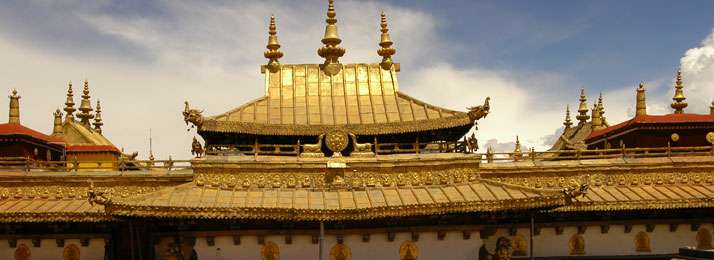
Tashi Lhunpo monastery is located in Shigatse town which is the second largest city in Tibet Autonomous Region, the monastery is very decent and marvelous looking from the outside that sometimes called as Heap of Glory. However, the monastery was founded in 1447 at the time of 1st Dalai Lama Gendun Drupa, who is a disciple of Tsongkapa. Hence, the monastery is also one of the biggest functioning monasteries of Gelukpa (yellow hat order). It covers an area of 70,000 square meters. The Dolma Ri (Tara’s Hill) is standing right behind the monastery surrounded by a lengthy white wall with prayer wheels all around the Kora path. Later at the time of the 4th Pachen Lama, the monastery slowly became residence and administration office of Pachen Lama lineages, and different renovation works carried by different Pachen Lamas lenages. There is a giant wall on the right side of the monastery which is used for displaying the Buddha thangka on 14th and 15th of the lunar calendar during Saka Dawa festival, it was originally built by the 1st Dalai Lama in 1468 and rebuilt recently. On the ground level, it is a beautiful experience to explore the twisted lanes through the old aged buildings. In the history, the monastery housed arround 4000 monks came from all over the Tibetan area. This monastery comprises chapel for the future Buddha Jampa Gonpo, numbers of funeral tomb stupas of all past Panchen Lama and old assembly hall.
History
The monastery was erected by the 1st Dalai Lama (Gedun Drupa) who is nephew and disciple of great Buddhist Philosopher Tsongkapa in the year 1447. Since from the time of the fourth Pachen Lama, it was become as the residence of the Pachen Lamas and at the time of each Pachen Lama, major expansions are enforced. However, the monastery is preserved so well that still once you visited inside you can wonder around the original arts, murals and buildings of the original monastery. At the time of the 1st Dalai Lama, in Tsang(western Tibet) area there is no particular Gelukpa monastery located. But once the monastery was built there financing by the local nobles, it became an active place for the religious people over there. During 1791, there is Nepalese attack over the monastery but there are no huge damages and destructions happened. In addition, the Mongolian king gave huge respect to the 1stPachen Lama and recognized as a great follower of the Buddhist teaching.
Nevertheless, the monastery is surrounded by huge prayer wheels all around the monastery where locals do Kora (circulation in clockwise) by spinning the wheels all around. Then entering the main gate gives a perfect view of the monastery. At ground level, there are many of white colored two floor buildings, which is particularly using as a residence for the monastery. As before Cultural Revolution, the monastery is housing for 4000 monks. At the same time, from the entrance the highest buildings at the backside give another amaze of visiting to the monastery, where the highest buildings are the four floor buildings containing the main and holiest images, statues, and tombs. The highest buildings from left to right is for, 1.Jamkhang Chenmo (future Buddha statue), the 32m giant statue of the future Buddha is made from copper alloy and bronze decorated with different precious stones. Is the biggest bronze and copper alloy statue in whole China with amazing wall paintings of the 1000 images of Buddha all around inside wall…2. Namgyal Lhakhang, located in-between the 1st and 2ndhighest chapel of the monastery, the two-floored building is especially for the Tsongkapa (Buddhist Philosophy Master) in the center with Jampa and Manjushiri at the sides. 3. Sisum Namgyal chapel, this chapel containing the tomb of the tenth Pachen Lama who died in 1989 that is gold plated stupa. Moreover, the Dukor (kalachakra) paintings and gold painted Buddha on the walls are another breathtaking. 4. Kundun Lhakhang, this is the funerary of the 4th Pachen Lama erected in gold and silver plated stupa. 5. Kelsang Lhakhang, located on the second floor where the ground floor is using as a debate courtyard practicing the philosophical religious debate by the monks in the monastery. However, there is a yellow clothe covered throne that is the throne of the 10th Pachen Lama, sitting there and watching the debate. Around the walls, you can see the colorful paintings of the 1000 images of Buddha. Then a black wooden pillar in the center of the yard, which is covered by yak furs all way to the top of the pillar.
At present, most of the buildings are not in use, hence, the four highest chapels are opened for both tourist and pilgrims including the Namgyal Lhakhang. Still during Saka Dawa (buddha’s birthday celebration), the monastery is displaying the huge Thangka painting of Buddha for three days, yet early in the morning, monks hang the painting until to the noon and then doing the same for next two days. Apart from the Thangka painting, the monastery is also worth full to do the Kora, which take like an hour near the Dolma Ri. The public ground in the front is also a perfect place to snapping with some friendly statues of both tourist and locals. From the distance, whitish wall on the right side gives a sense of humor that also leads your eyes on the Shigatse Dzong on a hill. Moreover, apart from the monastery, the Dechen Photang (the summer palace of Pachen Lamas) is also popular in Shigatse region.
